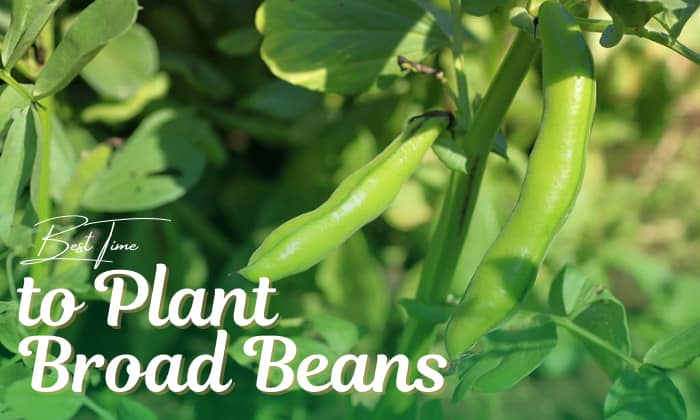
Broad beans, also known as fava beans, are native to the Mediterranean region. They are grown for their mild-tasting, protein-rich seeds and their role as cover crops due to their high nitrogen content.
Knowing when to plant broad beans is the first step when planning to grow these plants. Since broad bean seeds do well in cooler climates, they are usually planted in spring from February to April or in fall, from October to November, as long as the soil is workable and ground temperatures are favorable for germination.
Table of Contents
Best Time to Plant Broad Beans
Broad beans are cool-season crops that can tolerate temperatures as low as 40 degrees Fahrenheit and don’t thrive well in warmer climates. In the US, broad beans can be grown in USDA hardiness zones 3 to 11.
It is recommended to start planting fava beans 7 weeks before the estimated date of the last frost in your hardiness zone.
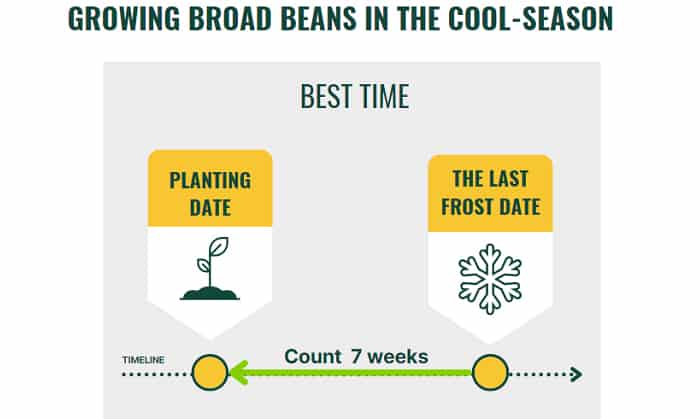
However, if you want to plant ahead of time for an early harvest, you can start planting 10 to 12 weeks before your last frost date. You can then transfer them outside once the ground is no longer frozen and add row covers to protect the plants from sudden drops in temperature.
Since fava beans are cold hardy and able to withstand temperatures as low as 10 degrees Fahrenheit, they can also be planted in the fall season, from October to November.
It is advisable to start sowing broad bean seeds 3 to 4 weeks before the first frost in your area to allow the seeds to germinate and roots to establish before the winter season. However, if your area experiences harsh winters, it would be best to add covers to protect the seedlings.
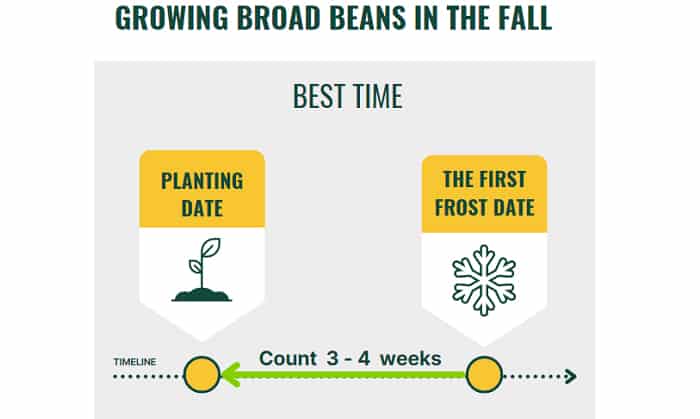
Note that a safer schedule is to plant eight weeks before the first frost.
You may refer to the table below for a quick guide, but bear in mind that these are average dates, and the final frost will still vary depending on your location and local weather condition.
| USDA Hardiness Zone | Average Date of Last Frost | Spring Planting Date | Average Date of First Frost | Fall Planting Date |
| Zones 3 and 4 | May 1 to May 31 | Mar 13 to Apr 12 | Sep 1 to Sep 30 | Aug 04 to Sep 02 |
| Zones 5, 6, 7 | Mar 30 to Apr 30 | Feb 09 to Mar 12 | Sep 30 to Oct 30 | Sep 02 to Oct 02 |
| Zone 8 | Feb 22 to Mar 30 | Jan 04 to Feb 09 | Oct 30 to Nov 30 | Oct 02 to Nov 02 |
| Zone 9 | Jan 30 to Feb 28 | Dec 12 to Jan 10 | Nov 30 to Dec 30 | Nov 02 to Dec 02 |
| Zone 10 | Jan 30 or earlier | Dec 12 or earlier | Nov 30 to Dec 30 | Nov 02 to Dec 02 |
| Zone 11 | No frost | Anytime | No frost | Anytime |
Types of Broad Beans
There are many varieties of broad beans, but below are the varieties commonly grown by commercial farmers and home gardeners:
- Windsor produces large, light green beans. This broad bean plant matures around 90 days after planting.
- Aquadulce Claudia also has an early maturity period of 90 days. If you are thinking of growing fava beans winter crops, this type is suitable as it can tolerate cold weather better than other varieties.
- The Sutton is a great cultivar if you have limited space in your home or garden. Sutton beans are ideal in pots as they grow to a height of just around 2 feet. This variety of broad beans can be harvested after 80 days.
- Sweet Lorane is a variety that has small, light brown beans. Their maturity period is about 100 days.
How to Plant It?
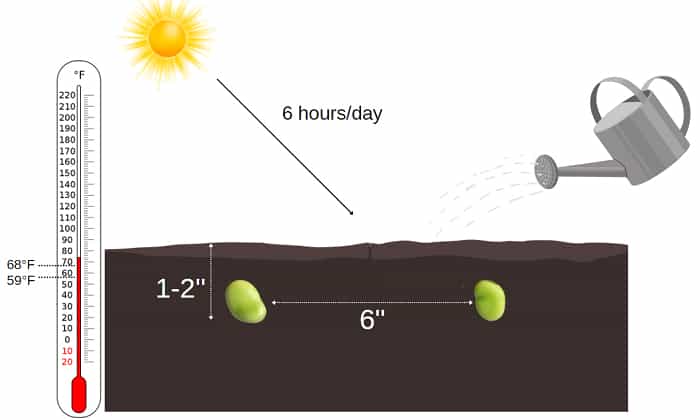
Below are the care requirements for a healthy broad bean plant:
- Choose a good planting site
Grow fava beans from seed by planting them directly into well-draining soil. These plants love sunlight, so be sure to put them in a spot where they can receive full sunshine, at least 6 hours a day.
- Prepare and plant your seeds
Purchase fava bean seeds from reputable nurseries or farms. Once you have selected your site, plant the seeds about 1 to 2 inches deep and maintain a 6-inch gap between the seeds. Water your seeds right after and continue to give them about 1 inch of moisture per week.
- Check the temperature
A temperature range of 59 to 68 degrees Fahrenheit is ideal during the broad bean plant’s flower and pod growing stages. Hence, they grow best in cooler weather.
It is also recommended to always keep tabs on the temperature because if it goes beyond 80 degrees Fahrenheit, the blossoms will drop and pod growing problems might arise (namely, failure to fruit).
- Watch out for pests
Aphids and black flies are the most common pests affecting broad bean plants, especially when the weather warms up. To minimize their numbers, you can pinch off the tips of your plant when the pods are beginning to form. You can also use oil- or soap-based insecticides to control the infestation.
Pea and bean weevils are pests that feed on broad bean leaf. To ward them off, you can cover the plant with fleece or use pheromone traps.
Growing Broad Beans in Pots
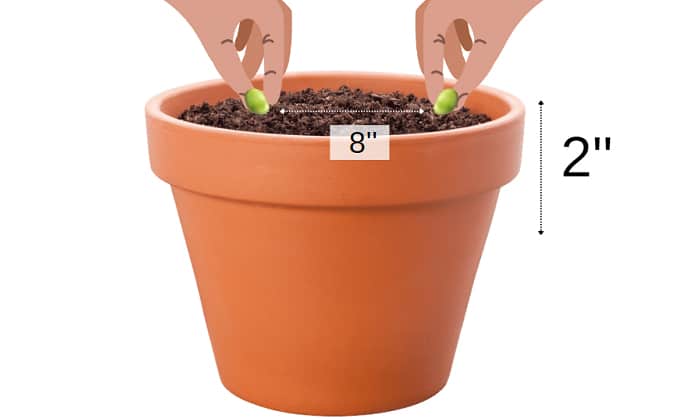
You can grow broad beans in pots, especially if you have limited garden space. All you need to do is select a pot with drainage holes that is appropriate for the size of your broad bean plant and place it in an area that receives full sunlight.
Usually, a planting depth of 5 cm or 2 inches should suffice. If you grow more than one plant, make sure to space them eight inches apart. As for the pots, 12-inch ones should fit about three plants.
Below are growing green beans in containers pictures you can check out.
Harvesting and Storing
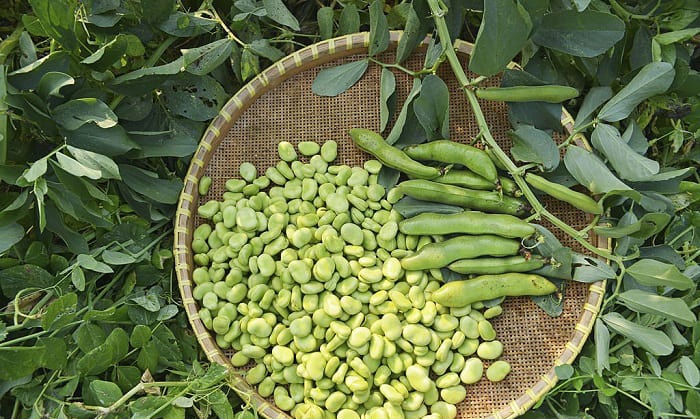
Broad beans growing time takes about 80 to 100 days, depending on the variety. You can harvest broad beans when the pods are full and they appear green and shiny. You can simply pick the pods off the plant or use a clean pair of scissors to remove them.
When storing the harvested pods, it is important to maintain the storage area’s temperature between 40 to 45 degrees Fahrenheit with a relative humidity of 95%. Otherwise, the quality and freshness of the beans might decline within a few days.
Frequently Asked Questions
What are some tips for growing broad beans?
- Broad beans favor cold weather, so it is best to plant them in early spring or around autumn.
- You can encourage the plant to become bushier by pinching out broad beans tops as soon as the flowers start to form.
Do you need to soak broad beans before planting?
Yes, you can soak broad beans for 12 to 24 hours before planting them. Doing so helps speed up germination.
How long does it take for broad beans to fully grow?
Broad bean varieties differ in their maturity days, but in general, most grow fully within 80 to 100 days.
Can you grow broad beans in autumn?
Yes! October bean seed can be sown in early autumn, and the growing plant will overwinter for an early spring harvest. Conclusion
Broad beans are terrific plants that are not only useful as food but also as a nitrogen provider to the soil.
Conclusion
They are relatively easy to grow, but before seeding them, you must first determine when to plant broad beans depending on your location and hardiness zone. From there, you’ll have your healthy broad bean plants in no time.
Here are some plating calendars of the most popular vegetables in the US, you can read via these articles:
- Best time to plant pumpkins in Indiana, Georgia, California and Missouri,…
- When is the best time to grow tomatoes in Ohio, Oregon and Florida, …
- Best time for potato planting in zone 6, zone 7, and zone 8

Hi, I am William – Floridayards’ digital content creator. My job is to find answers to all your concerns with thorough research and our team’s expert advice. I will also bring you honest reviews on the best products and equipment for raising your beautiful garden. Please look forward to our work!










